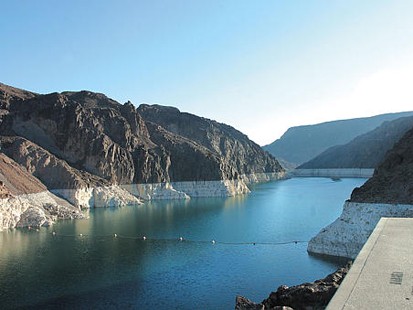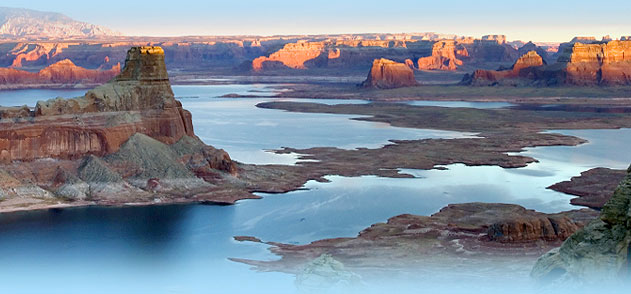
Laes Mead and Powell Could Run Dry By 2021
Peter N. Spotts - The Christian Science Monitor
February 13, 2008
Lake Mead and Lake Powell, which supply water and power to millions in the American Southwest, stand a 50 percent chance of running dry by 2021 unless dramatic changes take place in how the region uses water, according to a new study.

Photo: Lake Mead, located on the border of Arizona and Nevada, is shown in this July, 2004 file photo. If the current drought continues with no change in intensity and no change in the rate of reservoir releases, Phil Mutz, New Mexico's commissioner on the Upper Colorado River Compact Commission, said Lake Powell would approach dead storage _ the level at which no more water could be released _ in perhaps four years. (AP /The Mexican, Clyde Mueller)
Causes include growing population, rising demand for Colorado River water, which feeds both lakes, and global warming, according to scientists at the Scripps Institution of Oceanography in La Jolla, Calif., who conducted the study.
The results underscore the importance of water-conservation measures that many communities throughout the region are putting into place. Other studies, some dating back nearly 20 years, have projected that Lake Mead could fall to virtually useless levels as climate warmed, but they lacked a sense of the timing. The new results, the Scripps scientists say, represent a first attempt to answer when lakes Mead and Powell would run dry, squeezing water supplies in Arizona, California, Nevada, and New Mexico.
"We were stunned at the magnitude of the problem and how fast it is coming at us," notes Tim Barnett, a research physicist at Scripps who led the effort. By "dry," the team means that water levels fall so low behind the Hoover and Glenn Canyon Dams that the water fails to reach the gravity-fed intakes that guide it through turbines or out through spillways. In addition, the report estimates that the lakes stand a 50 percent chance of falling to the lowest levels required to generate electricity by 2017.
Last week, Dr. Barnett published additional work in the journal Science attributing 60 percent of the reduction in snowpack, rising temperatures, and reduced river flows over the past 50 years to global warming.

Photo: Lake Mead, located on the border of Arizona and Nevada, is shown in this July, 2004 file photo. If the current drought continues with no change in intensity and no change in the rate of reservoir releases, Phil Mutz, New Mexico's commissioner on the Upper Colorado River Compact Commission, said Lake Powell would approach dead storage - the level at which no more water could be released - in perhaps four years. (AP /The Mexican, Clyde Mueller)
The latest work "not only shows that climate change is a real problem. It also shows it has direct implications for humans – and not just in the third world," says Peter Gleick, president of the Pacific Institute in Oakland, Calif. The institute focuses on links between sustainable development and global security issues. "Even without climate change, we're taking too much water from the Colorado. So it's no surprise that if we continue to take too much, the reservoirs will go dry."
The message is not lost on water planners, adds Sharon Megdal, director of the Water Resources Research Center at the University of Arizona in Tucson. After years when discussions of climate change and water sat on the back burner, regional water managers are "beginning to get on the same page" regarding adaptation to global warming, she says. "At least they're asking the questions that need to be asked."
To Barnett, whose results have been accepted for publication in the journal Water Resources Research, time is of the essence. It takes so long for the planning process – and what some see as the inevitable legal challenges – to play out that he dubs the water-supply issue an "immediate" problem.
Given the effects of projected population growth on water resources, it might seem that the best solution would be to post "Keep Out" signs at state borders. But Dr. Gleick points out that changes in water use could go a long way toward easing the crunch. Such changes could include boosting the price of water to more closely reflect its value, requiring xeriscaping for homes and commercial centers, and on the farm, growing less water-intensive crops and using more miserly irrigation techniques. "Grow alfalfa in Minnesota or Iowa, not here," he says. "These are all plausible; they are not difficult decisions."
http://www.csmonitor.com/2008/0213/p25s05-usgn.html
www.standeyo.com/NEWS/08_Earth_Changes/080213.Powell-Mead.dry.2021.html
